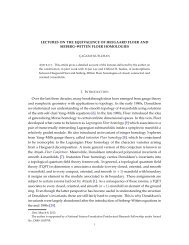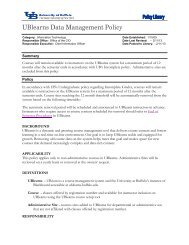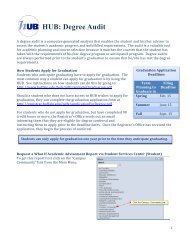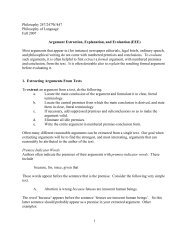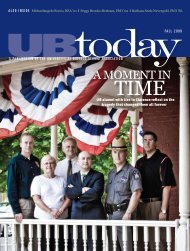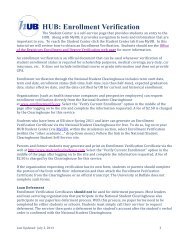Why children are getting and what UB is - University at Buffalo
Why children are getting and what UB is - University at Buffalo
Why children are getting and what UB is - University at Buffalo
Create successful ePaper yourself
Turn your PDF publications into a flip-book with our unique Google optimized e-Paper software.
As principal investig<strong>at</strong>or in a number<br />
of studies (<strong>and</strong> collabor<strong>at</strong>ing with Epstein,<br />
along with Samina Raja <strong>and</strong> Li Yin of the<br />
School of Architecture <strong>and</strong> Planning faculty),<br />
Roemmich found th<strong>at</strong> “<strong>children</strong> <strong>and</strong><br />
adolescents who lived in neighborhoods<br />
th<strong>at</strong> provided gre<strong>at</strong>er access to parks were<br />
more physically active.”<br />
However, “th<strong>at</strong> research didn’t answer<br />
whether <strong>children</strong> were actually using the<br />
parks to be physically active,” Roemmich<br />
points out.<br />
Further research showed th<strong>at</strong> “adolescents<br />
most frequently used their home lot,<br />
their friend’s lots, parks <strong>and</strong> vacant lots<br />
to get their physical activity.” Roemmich<br />
<strong>and</strong> h<strong>is</strong> team also <strong>are</strong> studying how park<br />
design—such as the choice of play equipment<br />
within parks—motiv<strong>at</strong>es <strong>children</strong> to<br />
be physically active.<br />
Adds Roemmich: “We <strong>are</strong> now studying<br />
whether reducing access to telev<strong>is</strong>ion <strong>and</strong><br />
computer time by 50 percent within the<br />
home encourages overweight adolescents<br />
to go outside <strong>and</strong> be physically active, <strong>and</strong><br />
whether those who have access to neighborhood<br />
parks find it easier to increase<br />
their physical activity.”<br />
At <strong>UB</strong>’s Childhood Weight Control<br />
Program, which Epstein heads, one<br />
research study combines healthier e<strong>at</strong>ing<br />
behavior, innov<strong>at</strong>ive ways to increase<br />
activity <strong>and</strong> behavior modific<strong>at</strong>ion to help<br />
overweight <strong>children</strong> between the ages of<br />
8 <strong>and</strong> 12, <strong>and</strong> who have <strong>at</strong> least one overweight<br />
p<strong>are</strong>nt, to lose weight <strong>and</strong> then<br />
maintain a normal weight.<br />
Breaking the cycle<br />
In an especially innov<strong>at</strong>ive study, Teresa<br />
Qu<strong>at</strong>trin, <strong>UB</strong> professor of pedi<strong>at</strong>rics <strong>and</strong> a<br />
special<strong>is</strong>t in childhood endocrinology <strong>and</strong><br />
diabetes, <strong>is</strong> testing the effectiveness of a<br />
tre<strong>at</strong>ment to be carried out <strong>at</strong> the pedi<strong>at</strong>rician’s<br />
office in collabor<strong>at</strong>ion with the<br />
family <strong>and</strong> the child’s doctor. The aim <strong>is</strong> to<br />
break the cycle of obesity in families.<br />
Since <strong>children</strong> of overweight p<strong>are</strong>nts<br />
<strong>are</strong> <strong>at</strong> r<strong>is</strong>k to become overweight early in<br />
life, <strong>and</strong> overweight <strong>children</strong> <strong>are</strong> <strong>at</strong> r<strong>is</strong>k<br />
of becoming obese adults, Qu<strong>at</strong>trin has<br />
shifted her focus to younger <strong>children</strong>. In<br />
Western New York, she says, three out of<br />
10 young <strong>children</strong> <strong>are</strong> close to being overweight<br />
or <strong>are</strong> already overweight.<br />
“In the summer of 2002, realizing th<strong>at</strong><br />
the number of overweight <strong>children</strong> without<br />
additional hormonal d<strong>is</strong>orders was<br />
increasing alarmingly, I decided to analyze<br />
the d<strong>at</strong>a pertinent to the <strong>children</strong> referred<br />
by Western New York pedi<strong>at</strong>ricians [to<br />
the endocrinology clinic <strong>at</strong> the Women<br />
<strong>and</strong> Children’s Hospital of <strong>Buffalo</strong>] over<br />
the previous 10 years,” says Qu<strong>at</strong>trin,<br />
chief of service for pedi<strong>at</strong>rics for Kaleida<br />
Health. Serving also as interim chair of the<br />
Department of Pedi<strong>at</strong>rics, she points out<br />
th<strong>at</strong> the current project “would not be possible<br />
without the critical mass of scient<strong>is</strong>ts<br />
from the Department of Pedi<strong>at</strong>rics, who<br />
<strong>are</strong> invaluable collabor<strong>at</strong>ors.<br />
“These d<strong>at</strong>a, among several things,<br />
illustr<strong>at</strong>ed th<strong>at</strong> there was a delay between<br />
the time the child was becoming overweight<br />
<strong>and</strong> the referral [by the pedi<strong>at</strong>rician],”<br />
Qu<strong>at</strong>trin continues. “Growth d<strong>at</strong>a<br />
provided by the pedi<strong>at</strong>rician in about 251<br />
<strong>children</strong> showed th<strong>at</strong> more than 80 percent<br />
of <strong>children</strong> who had been referred<br />
to our endocrinology clinic had in fact<br />
become overweight before school age.<br />
“Th<strong>is</strong> was the point in my c<strong>are</strong>er when<br />
I decided th<strong>at</strong> our focus had to shift from<br />
adolescence to early childhood. Also, it<br />
became clear th<strong>at</strong> we needed to involve the<br />
family, <strong>and</strong> th<strong>is</strong> was an ideal situ<strong>at</strong>ion in a<br />
young child who <strong>is</strong> still totally dependent<br />
on h<strong>is</strong>/her p<strong>are</strong>nts.”<br />
Working with practices in the <strong>Buffalo</strong><br />
<strong>are</strong>a th<strong>at</strong> <strong>are</strong> affili<strong>at</strong>ed with Women<br />
<strong>and</strong> Children’s Hospital—Amherst<br />
Pedi<strong>at</strong>rics, Suburban Pedi<strong>at</strong>rics <strong>and</strong> Hodge<br />
Pedi<strong>at</strong>rics—the researchers <strong>are</strong> investig<strong>at</strong>ing<br />
whether the program can promote<br />
weight maintenance or modest weight loss<br />
in <strong>children</strong> ages 2 to 5 while the <strong>children</strong><br />
grow in height, <strong>and</strong> whether the child will<br />
see a decreased percentage BMI over time.<br />
Baby f<strong>at</strong> not ‘cute’<br />
Changing e<strong>at</strong>ing <strong>and</strong> activity p<strong>at</strong>terns also<br />
<strong>are</strong> a part of the study. The preschool-age<br />
<strong>children</strong> will be taught good e<strong>at</strong>ing habits<br />
before they have to “unlearn” bad ones.<br />
P<strong>are</strong>nts will learn th<strong>at</strong> a young child who<br />
<strong>is</strong> rapidly gaining weight <strong>is</strong> <strong>at</strong> r<strong>is</strong>k for<br />
obesity, <strong>and</strong> th<strong>at</strong> the problem needs to be<br />
addressed—<strong>and</strong> not ignored or d<strong>is</strong>m<strong>is</strong>sed<br />
because of cultural perceptions th<strong>at</strong> “baby<br />
f<strong>at</strong> <strong>is</strong> cute.”<br />
“In th<strong>is</strong> pioneer transl<strong>at</strong>ional project,<br />
pedi<strong>at</strong>ricians <strong>are</strong> playing a key role on the<br />
team,” Qu<strong>at</strong>trin explains. “They identify<br />
young <strong>children</strong> when they <strong>are</strong> <strong>at</strong> r<strong>is</strong>k for<br />
[becoming] overweight, or <strong>are</strong> overweight,<br />
<strong>and</strong> counsel the family th<strong>at</strong> th<strong>is</strong> <strong>is</strong> the<br />
time they can benefit from the program.<br />
“In cases when the child <strong>is</strong> <strong>at</strong> r<strong>is</strong>k for<br />
[becoming] overweight, maintaining the<br />
weight will gradually make the child wellproportioned.<br />
[But] if the child <strong>is</strong> already<br />
overweight, weight loss <strong>is</strong> necessary while<br />
the child grows in height.”<br />
Another approach to the childhood<br />
obesity problem explored <strong>at</strong> <strong>UB</strong> <strong>is</strong> how the<br />
environment can influence food selection,<br />
food intake <strong>and</strong> activity choices (physical<br />
or sedentary) in both <strong>children</strong> <strong>and</strong> adolescents.<br />
“More specifically, I am interested<br />
in the effects of social influence on e<strong>at</strong>ing<br />
<strong>and</strong> activities in overweight <strong>and</strong> non-overweight<br />
youth,” Salvy explains.<br />
“We’ve been conducting several studies<br />
assessing how peer rel<strong>at</strong>ionships, or<br />
the lack thereof, impact youth’s e<strong>at</strong>ing <strong>and</strong><br />
physical activity. These studies indic<strong>at</strong>e<br />
th<strong>at</strong> overweight youth (but not lean youth)<br />
e<strong>at</strong> more when alone than when in the<br />
presence of peers, <strong>and</strong> <strong>are</strong> also less physically<br />
active when alone than when in company<br />
of other youth,” Salvy says.<br />
“In fact, we showed th<strong>at</strong> the presence<br />
of peer <strong>and</strong> friends can increase the value<br />
of physical activity in overweight youth. In<br />
other words, overweight youth <strong>are</strong> more<br />
likely to engage in physically active le<strong>is</strong>ure<br />
activities when they have the opportunity<br />
Global airing<br />
for <strong>UB</strong> obesity<br />
research<br />
News outlets<br />
from all over<br />
the world<br />
reported on<br />
the study<br />
conducted <strong>at</strong> <strong>UB</strong> by Leonard H. Epstein,<br />
chief, Div<strong>is</strong>ion of Behavioral Medicine,<br />
Department of Pedi<strong>at</strong>rics in the <strong>UB</strong> School<br />
of Medicine <strong>and</strong> Biomedical Sciences. It<br />
revealed th<strong>at</strong> w<strong>at</strong>ching TV <strong>and</strong> playing computer<br />
games can lead to obesity in <strong>children</strong><br />
by reducing the amount of time they <strong>are</strong><br />
physically active.<br />
The results of the study appe<strong>are</strong>d in<br />
the March 2008 <strong>is</strong>sue of the Archives of<br />
Pedi<strong>at</strong>ric & Adolescent Medicine, <strong>and</strong> were<br />
picked up by U.S. news outlets, including<br />
USA Today, the New York Times, New<br />
York Daily News, Fox News, Denver Post,<br />
N<strong>at</strong>ional Public Radio, Bloomberg News,<br />
Reuters, Washington Post, Chicago Tribune,<br />
Pittsburgh Post-Gazette, U.S. News &<br />
World Report, Se<strong>at</strong>tle Post Intelligencer <strong>and</strong><br />
United Press Intern<strong>at</strong>ional.<br />
The research also gained intern<strong>at</strong>ional<br />
<strong>at</strong>tention through media reports in India,<br />
Canada, Engl<strong>and</strong>, Australia, Scotl<strong>and</strong>, Sri<br />
Lanka, Thail<strong>and</strong>, New Zeal<strong>and</strong>, Malaysia<br />
<strong>and</strong> Estonia.<br />
www.alumni.buffalo.edu <strong>UB</strong>TODAY Winter 2009 15



